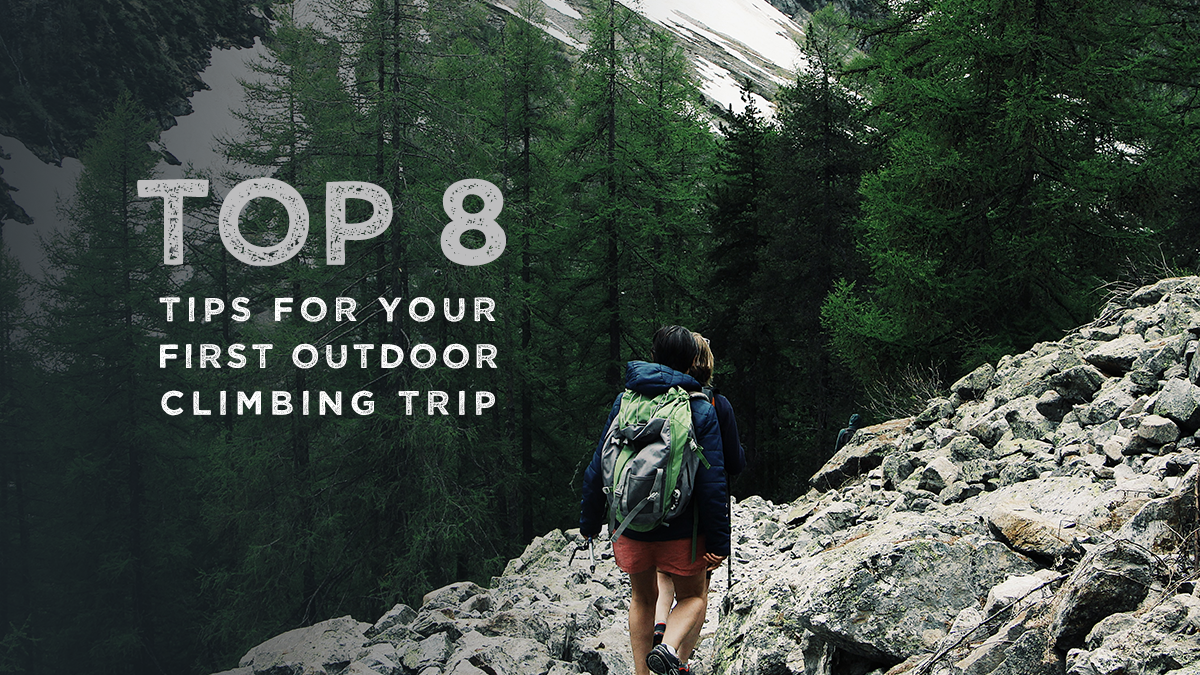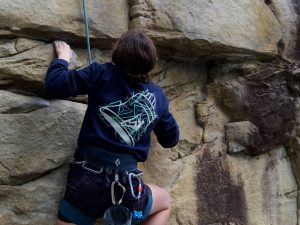For many climbers, outdoor climbing trips are the best part of the sport. If you are gearing up for your first outdoor climbing trip and are still determining what to expect, you’re in the right place! You may have been climbing in a gym before, or you happen to have friends introducing you to rock climbing for the first time, and it’s on real rock! Don’t worry—we have you covered. We’ll review the top 8 tips for your first outdoor climbing trip so you’ll be ready to tackle rock in no time.
How to Set Up a Top Rope for Climbing Outdoors
Setting up the rope may not be obvious to beginners. In a gym, most routes already have a rope threaded through the clips or bar at the top of the wall. So, often, you don’t think of how it got up there. There are a couple of ways a top rope is set up:
- In some climbing areas, you can hike around the base of the cliff to the top, where we find the anchors. After making sure the rope isn’t tangled and you’ve clipped it through the middle, yell, “ROPE,” to warn people at the bottom that a rope will be hurled toward them.
- An anchor must be built if there are no anchors at the top of a wall you want to climb. That is a more advanced climbing technique. Seek out an experienced climber or expert to teach you. Try reaching out to your local climbing gym for private lessons.
- Climbing a route from the ground up is called sport, or lead climbing. A climber will be tied in while the belayer feeds out slack as they progress up the wall. At each bolt, the climber will attach a piece of gear, usually a quickdraw, until they reach the top and clip the anchors with the rope. After being lowered down, you now have a top rope set up.
Cleaning a Route
Cleaning a route is extremely important to know while climbing outside. That is the process of retrieving all your gear after a climb. If it’s your first time outdoors without experienced climbers, practice thoroughly on the ground first.
Guidebook
It’s frustrating to have all your gear ready only to realize the route you’re on is way above your pay grade. Download an app like Mountain Project or invest in a guidebook for the area you plan to climb to ensure you hop on something that won’t immediately shut you down.
The Approach
Suppose you plan to camp while on your first climbing trip, expect to hike to the walls each day. Usually, camping near climbing cliffs is prohibited. Each morning or early afternoon, depending on how psyched you are, you’ll gather your gear and hike to where you want to climb. That is called “the approach.”
Reading a Route
Learning to read a route, either from the ground or on the wall, is trickier than reading a route indoors. In a gym, all the holds can usually be seen from the ground and are color-coordinated; therefore, you know exactly where to grab them. While outdoors, you may have five different options that look like good handholds, while two of them are easier than the rest, and everything is the same color. Finding the best handholds on a route outside will take more strength and endurance.
Bouldering
If you’re going bouldering, ensure you know how to spot and fall. This includes where to place the pads, how to move them if necessary, and how to direct a climber to those pads in a fall. As for falling, sprained ankles are common injuries while bouldering so learning the proper way to do so will mitigate this.
Distance Between Bolts
The distance between protection points outside can be shocking if you’re used to sport climbing in a gym. Gyms usually have somewhere to clip the rope every few feet, while outside routes can have a much further distance. That will take some getting used to, so remember to be confident in your climbing. If the first bolt is far off the ground, to avoid decking, think of investing in a stick clip or learning how to fashion one out of a long stick. That will allow you to clip the first bolt from the ground to avoid an unexpected ground fall.
Rock is sharp!
Three types of rock where you’ll find most climbs are on granite, limestone, and sandstone formations. You can have calloused fingers from gym climbing, but nothing indoors is like the sharp crystals of granite. Even though sandstone is the softest rock of the bunch, it can still be quite sharp and throw new outdoor climbers for a loop.
NOTE: (Never climb sandstone after it rains. It is a fragile rock formation that can break when wet. Wait at least 48-72 hours before climbing. Factors like rain/humidity/storm duration can lengthen this time).
The Most Successful Trips
Climbing outside can be daunting, but you’ll never experience the same sensations climbing in a gym. If you need more confidence about your or your friend’s ability to do so, entertain the idea of taking a gym-to-crag class or seek a certified instructor to teach you the ropes. The most successful outdoor climbing trips are the safest ones!









